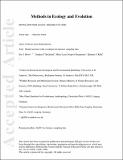Model selection with overdispersed distance sampling data
Abstract
1. Distance sampling (DS) is a widely used framework for estimating animal abundance. DS models assume that observations of distances to animals are independent. Non‐independent observations introduce overdispersion, causing model selection criteria such as AIC or AICc to favour overly complex models, with adverse effects on accuracy and precision. 2. We describe, and evaluate via simulation and with real data, estimators of an overdispersion factor (ĉ), and associated adjusted model selection criteria (QAIC) for use with overdispersed DS data. In other contexts, a single value of ĉ is calculated from the “global” model, that is the most highly parameterised model in the candidate set, and used to calculate QAIC for all models in the set; the resulting QAIC values, and associated ΔQAIC values and QAIC weights, are comparable across the entire set. Candidate models of the DS detection function include models with different general forms (e.g. half‐normal, hazard rate, uniform), so it may not be possible to identify a single global model. We therefore propose a two‐step model selection procedure by which QAIC is used to select among models with the same general form, and then a goodness‐of‐fit statistic is used to select among models with different forms. A drawback of thi approach is that QAIC values are not comparable across all models in the candidate set. 3. Relative to AIC, QAIC and the two‐step model selection procedure avoided overfitting and improved the accuracy and precision of densities estimated from simulated data. When applied to six real datasets, adjusted criteria and procedures selected either the same model as AIC or a model that yielded a more accurate density estimate in five cases, and a model that yielded a less accurate estimate in one case. 4. Many DS surveys yield overdispersed data, including cue counting surveys of songbirds and cetaceans, surveys of social species including primates, and camera‐trapping surveys. Methods that adjust for overdispersion during the model selection stage of DS analyses therefore address a conspicuous gap in the DS analytical framework as applied to species of conservation concern.
Citation
Howe , E J , Buckland , S T , Després-Einspenner , M-L & Kühl , H S 2019 , ' Model selection with overdispersed distance sampling data ' , Methods in Ecology and Evolution , vol. 10 , no. 1 , pp. 38-47 . https://doi.org/10.1111/2041-210X.13082
Publication
Methods in Ecology and Evolution
Status
Peer reviewed
ISSN
2041-210XType
Journal article
Description
We thank the Robert Bosch Foundation, the Max Planck Society and the University of St Andrews for funding.Collections
Items in the St Andrews Research Repository are protected by copyright, with all rights reserved, unless otherwise indicated.

